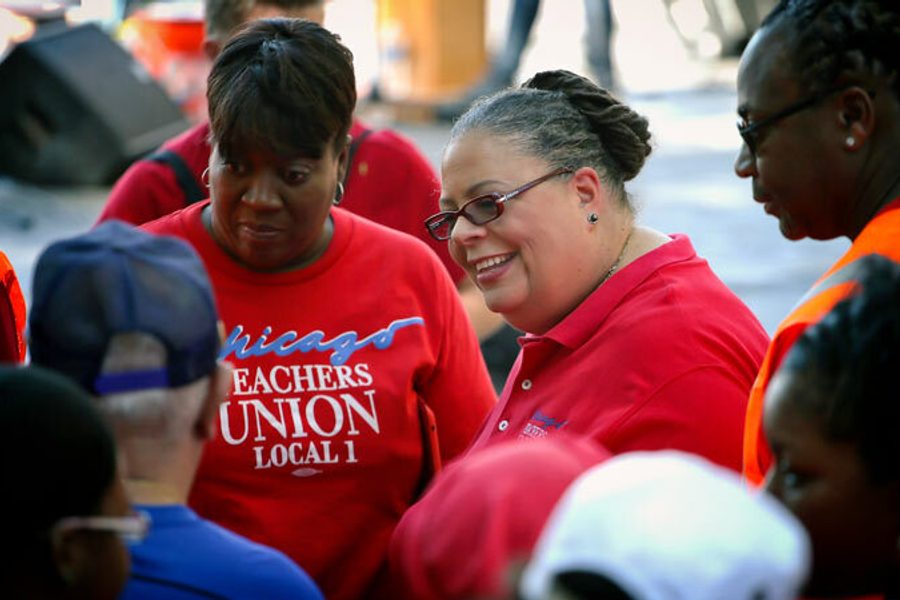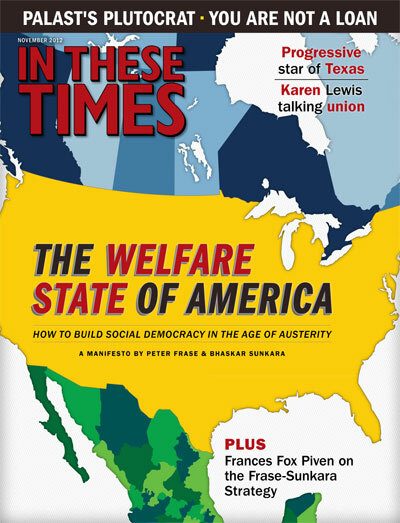Karen Lewis Drops Knowledge
The Chicago Teachers Union president has the formula for change.
Jude Ellison Sady Doyle

There’s no bulldozing Karen Lewis. As the president of the Chicago Teachers Union and the public face of its historic strike, she held her ground against opeds by billionaires, liberal media scrutiny and the education “reform” establishment. She was direct, biting and funny. She had the nerve to call Mayor Rahm Emanuel not only a “bully” (which he is) but also a “liar.” Given that the man has a reputation of being able to shout the paint off a Buick, that takes no small amount of confidence.
Her critics said she was sticking up for teachers who weren’t doing their jobs, that she was harming kids by keeping them out of school, that she was rude and mean and should stay out of the spotlight. A YouTube clip of her mocking Education Secretary Arne Duncan’s lisp was featured in the New York Times.
She was portrayed—as women who stand their ground in public are often portrayed—as angry, unreasonable, destructive, you name it. Not to mention that extra vitriol doled out when that woman is a woman of color, and the final dollop of scorn reserved for those who are “hurting children.”
But Karen Lewis and the legion of Chicago teachers who have come to revere her stood firm. They held the line against Emanuel’s corporate “reforms.” They secured better pay, a recall policy for top teachers laid off in school closings, and 600 new teachers in “enrichment” classes in art and music.
When In These Times Editor & Publisher Joel Bleifuss and I spoke with her, the former high school teacher seemed to have a “sticks and stones” philosophy about the mudslinging. “I really don’t care about any of that,” she said simply. “What’s important to me is the message. And what’s important to me is that people who are struggling in working conditions around this country and being blamed for them need to be able to have some sort of voice.”
Their voices have now been heard across the country, thanks in part to Lewis. Her message is simple: Blaming teachers for the “failure” of schools isn’t working, and corporate-style school reform— which would have teachers competing with each other for decent pay based on their students’ test scores— won’t either. What teachers need are the resources necessary to do their jobs, and the respect (not to mention job security and compensation) that, as skilled professionals, is their due.
In the seven days Chicago teachers were out on strike, Lewis became one of America’s most famous union leaders— a woman who is now extolled as a model for revolutionary black womanhood. Being a role-model seems to sit pretty easily on Lewis, perhaps because she has no questions about who or what she is: first and foremost, a teacher.
Her passion is palpable when she describes what it’s like to be a public school teacher in America today. People who have never worked in a classroom are dictating policy. They can float one policy that ends up devastating schools, and then, when that fails, float out the next. Teachers like Lewis are expected to blithely follow the leader, keeping their experience to themselves.
The challenge has been, she says, getting a group of people that was not used to “tooting its own horn”—teachers, and primarily women—to stand up for themselves.
Lewis doesn’t have trouble with this herself. Her father, she says, was a “proto-feminist,” and she’d never been told that there were things she couldn’t do. He taught Lewis, who is right-handed, to bat left-handed. She recalls, “I asked him why, and he said its an advantage, because in the major leagues right field is always shorter. He never bothered to tell me I was not going to play major league ball.” So Lewis did whatever she believed she could and should do.
Asked whether being a woman had affected her leadership style, she replied, “I’ve always been a woman, so, you know, I don’t know what it means to be a dude.” Touché.
Lewis was the only black woman in Dartmouth’s class of 1974, two years after the school went co-ed. The experience was a bad one, she told Dartmouth’s alumni magazine, but she explained to me that it made her familiar with, and undaunted by, being “the only or the first or the this or the that.” She holds one master’s degree in inner-city studies education and a second in film and video. Prior to being elected president of Local 1, she taught chemistry in the Chicago Public Schools for 23 years.
“I think I’m the right person to be at this place at this time,” she says, “somebody who is absolutely passionate about teaching and learning, who cares about what happens. I am a product of Chicago Public Schools. My parents taught in Chicago Public Schools. My husband is a retired Chicago Public Schools teacher. This means something to me; it’s personal.”
For Lewis it came down to this: There is a difference in perspective between an education “reformer” like Bill Gates, who dictates education policy from his super-computerized robot mansion in Seattle, and teachers who have devoted their lives to their students.
As Lewis sees it, two groups of people have a direct, personal investment in making sure that schools serve students: teachers and parents. A huge part of her work was about getting those primary stakeholders in the schools to recognize their common interest. This relationship- building work paid off: A major reason teachers didn’t cave was that they had overwhelming community support, especially from parents.
A poll taken during the strike showed that 66 percent of parents with children in the city’s public schools supported the striking teachers. The key, she said, was demonstrating that “parents and teachers have way more in common with each other than with the millionaires and billionaires who sit on the Board of Education.
“I always tell people you need to ask three questions,” she continued. “The first is the one everybody has an answer to, which is, ‘Who are the winners and losers?’ The harder question starts to be, ‘Who made the rules of the game?’ If you start noticing that someone is winning all the time and someone is losing all the time, then we need to now look at who is making the rules. So right now the conversation is, ‘Schools are failing’. Who made that rule that schools are failing? And the third and deepest question— and I get this from Lani Guinier, the Harvard law professor—is ‘How do you get the losers to continue playing the game?’ And when you start thinking about this, it puts everything else in a different perspective.”
As she laid this out, I couldn’t help but envision her at the head of a classroom. I asked her if she thought her current work, re-framing and explaining these complicated battles, was a way of educating the country.
“That’s why I’m here,” she said. “I absolutely love teaching. When I say, ‘I’m good at my job,’ that’s what I’m proud of—not this union job. I taught chemistry— and it’s a really hard, abstract subject— and I prided myself on being able to teach chemistry to kids who were not necessarily scientifically inclined. I always preferred to teach regular classes as opposed to honors class, because it was a much bigger challenge. So how do you convince someone who’s convinced they can’t do something that you know they can? That’s what I’ve been doing for the last 23 years.”
It’s that simple. You listen, you learn. It doesn’t matter how hard it looks, what you’re up against, or if you think you can’t do it. Karen Lewis knows you can.
Class dismissed.
Jude Ellison Sady Doyle is an In These Times contributing writer. They are the author of Trainwreck: The Women We Love to Hate, Mock, and Fear… and Why (Melville House, 2016) and was the founder of the blog Tiger Beatdown. You can follow them on Twitter at @sadydoyle.









